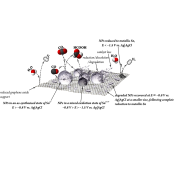
Probing the Chemical State of Tin Oxide NP Catalysts during CO2 Electroreduction: A Complementary Operando Approach
The paper authored by
A. Dutta,
A. Kuzume,
V. Kaliginedi,
M. Rahaman,
I. Sinev,
M. Ahmadi,
B. Roldán Cuenya,
S. Vesztergom and
P. Broekmann
is published in Nano Energy (2018, vol. 53, pp. 828–840).
Abstract:
In this paper we combine two operando methods, Raman spectroscopy and X-ray absorption spectroscopy (XAS), in order to probe reduced graphene-oxide supported tinIV oxide nanoparticles (SnO2NPs@rGO) as they are being used to catalyse CO2 electroreduction. To achieve high reaction rates it is necessary to apply sufficiently cathodic electrode potentials. Under such conditions, however, not only CO2 is reduced electrochemically, but also the catalyst particles may be transformed from the initial SnIV state to SnII or, in an extreme case, to metallic Sn. While SnII species still favour CO2 electroreduction, yielding formate as a primary product, on metallic Sn CO2 reduction is disfavoured with respect to the competing hydrogen evolution reaction (HER). We show that operando XAS, a robust technique yielding information averaged over a large surface area and a relatively large thickness of the catalyst layer, is a very expedient method able to detect the reduction of to metallic Sn. XAS can thus be used to establish an optimum potential for the electroreduction in practical electrolysing cells. It takes, however, a complementary method offered by operando Raman spectroscopy, having greater sensitivity at the catalyst/electrolyte solution interface, to probe reduction intermediates such as the SnII state, which remain undetectable for ex situ methods. As it is shown in the paper, Raman spectroscopy may also find further use when investigating the recovery of catalyst particles following exposure to extreme reducing conditions.